Using the gloves to turn a shilling or a crown: gloved sparring in the late eighteenth to mid- nineteenth century
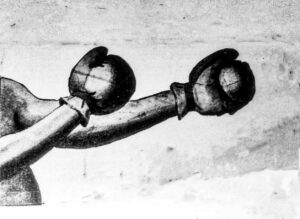 A history of gloved exhibition boxing in Ireland. By Ray Esten
A history of gloved exhibition boxing in Ireland. By Ray Esten
In devotion to Simon Byrne and his kin -the battling kind
Gloved sparring
The gloves were introduced to boxing by Jack Broughton, who wrote the first rules of the Prize Ring in 1743. They served the gentry who enjoyed the sport, at Broughton’s premises, without suffering any serious injury to the face or hands.[1] It was much later in the century before they were integrated into the gymnasium. Sparring was defined, in the 1780s, as practiced merely as an art, an exercise, by two persons, without any intention of hurting each other.[2] Very little serious work was done with the gloves and very seldom were they used in a fight, for a stake or a purse.[3]
Gloves were first used in boxing for sparring and exhibition matches.
Pugilists acquired their guineas by way of their fists, but they earned shillings and crowns with the gloves as instructors on the science of boxing, by a form of gloved sparring known as the exhibition.[4] The latter showcased their skill, as public entertainment, at the theatre or music hall. It attracted the amateurs and those interested in self-defence.
Whilst it had the advantage of being indoors, bringing the pugilist in out of the elements, it was the financial factor, once combined with a sense of respectability (especially for the Irish fighter) that made for exhibition fights with gloves a worthwhile venture. Besides, fighters had short careers and fought far less than their gloved successors. Therefore, the exhibition was perhaps the perfect vehicle to navigate the unpredictability of the Prize Ring.
The pugilistic world
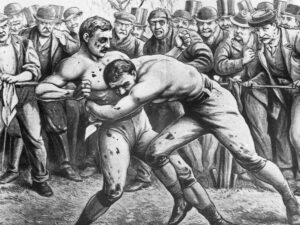
The world of prize fighting revolved around Britain and Ireland. In fact, they were the home of the Prize Ring. By the mid-century the largest city apart from London, in that world was Dublin.[5] Though Dublin had developed physically over the 1780s, however, it suffered from an inadequate poor law to relieve the poverty that was widespread there.[6]
The Dublin Police Act of 1786 created a professional police force in the city (a similar act was had been defeated in England).[7] Yet, this was hardly celebrated by those who made their coin terrain vague. Ultimately, the eyes of law looked upon prize fighting with despair. They viewed it to be a blunt instrument of the gambler, who wagered on fist blood or first to fall.
The world of prize fighting revolved around Britain and Ireland
The restoration of royal patronage to boxing in England coincided with the championships of Dan Mendoza and Tom Johnson.[8] The tavern owners and innkeepers provided the infrastructure for prize fighting to make it a successful enterprise.[9] This contrasted with Ireland were the sport of boxing was underdeveloped and found little support outside of the artisan class. Nevertheless, Irish pugilists applied their trade on both sides of the water.[10]
The allure of the exhibition
The Irish champion Mike Ryan was in the land of John Bull in 1787[11] where he challenged Tom Johnson (champion of England) in a fight where the prize money was a hundred guineas.[12] However, it was the jeers of Johnson after the defeat of Irishman Jacob Doyle which induced Ryan (Doyle’s second[13]) to issue a challenge. They met in September of that year. Ryan delivered coup de main and was about to finish the job when Humphries (Johnson’s second) grabbed Ryan’s arm.
The fight continued after much confusion. By the end of their encounter Ryan was partially blinded and Johnson emerged the winner; a chaotic event even by the standards of the day.
By all accounts it should have made them mortal enemies. Yet Ryan and Johnson set out on an exhibition of sparring thereafter. Undoubtedly, the financial benefits excited them, outweighing any hostilities, they may have had. Indeed, it was more than a year before they met again to decide the vexed question of supremacy.[14]
Mendoza takes the show on the road
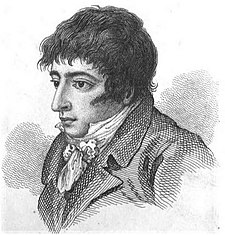
Jewish Londoner Dan Mendoza (who had attended Ryan at his fight with Johnson) is remembered for his epic battles. He was quick to comprehend the opportunities posed by gloved sparring.
He offered his services, for a fee. However, the exchange of money was declared unlawful and In response, Mendoza acquired the assistance of a freeman of the city of London to sell his engraved portrait. The purchaser was invited – no money was required.[15]
Mendoza fought Dick Humphries in January of 1788, but it was their last two fights that generated the most enthusiasm. It was during this period that Mendoza brought the exhibition on tour, presenting the gloved personality to a wider audience. This did much to bring the gloves into favour[16] In all probability it did for gloved sparring what John L. Sullivan’s exhibition tour did for competitive gloved boxing a century later.
Prize fighters such as Dan Mendoza of London popularised the exhibition match as a means of making money whole not risking injury
Mendoza toured Dublin in 1790. Four years later he won the championship and became a public character. In financial difficulty he carried on fighting. He also carried on giving exhibitions (Imitating the art of famous boxers past and present),[17] setting a trend in which the exhibition was exercised to prolong and, in some cases, revive a career.
Englishmen on the Emerald Isle
Tom Johnson, the English boxer who fought Ryan, settled in Dublin in 1797. He kept a public house at Cooper Alley (the ultimate sign of success for a prize fighter), but was ‘rooted by the magistrate’ i.e. lost his licence on account of gambling practices and frequenters. [18]
He subsequently relocated to Cork where he supported himself by teaching the art of pugilism,[19] there being a demand for experienced teachers in this period. Top English pugilists like Tom Belcher (the best gloved performer of his time) also journeyed in Ireland. [20]
In fact, his fight with Dan Dogherty at the Curragh in 1813[21]was instigated because the Englishman had come to teach the milling art. In this instance he hit Dogherty where it hurt most (in the pocket).[22] Evidently, they settled the dispute the best way they knew how[23]
The exhibition- the making of Dan Donnelly

The celebrated Dan Donnelly started his career as an untutored pugilist. In fact, his fight with Tom Hall in 1813 was billed as a’ trial between bodily strength and science.’ Yet, he animated the sport, quite unexpectedly[24] Evidentially, he had natural talent. But, he also benefited from repeated use of the gloves. His benefits, at the Olympic Theatre in Dublin, were in general numerously attended by the amateurs.[25]
Fellow Dubliner Patrick Halton[26]who was described as a pet pupil of the great ‘’Sir’’ Daniel[27] also attracted the amateurs. This time at the Circus, in Sackville Street (O’Connell St.). Donnelly and Halton put on the gloves at the Theatre Royal in Crow Street.[28] The exhibition certainly endeared them to their admirers.
Irish fighters like Dan Donnelly benefited from repeated use of the gloves in between bare knuckle fights.
Yet it was Donnelly’s time in England that advanced him real rewards. What’s more, his budding reputation intrigued their fancy. In response, Donnelly and Jack Carter, an English fighter who had settled in Dublin, gave a demonstration at Manchester. This was quite lucrative and was repeated at Liverpool then London.
Donnelly proved himself a straight hitter, and his Adonis figure was viewed with collective admiration.[29]However, he also recognised the advantage of self-promotion.
In fact, the exhibition had been boldly headed in large letters DONNELLY the champion of Ireland and CARTER the champion of England. It had the desired effect.[30]In fact, the excitement created at London somewhat boosted the profile of a sport in decline.[31]
When Donnelly returned to ‘Ould Ireland’ (after his fight with Tom Oliver) he opened a booth at Donnybrook Fair. Wherein (George) Cooper, (Bob) Gregson[32]and the Irish champion exhibited sparring to the great amusement of the admiring audience.[33] Gregson and Cooper were renowned English pugilists. The latter had been defeated by Donnelly at the Curragh in 1814. Yet, he had the fortitude to disregarded past antipathies in exchange for mutual benefits.
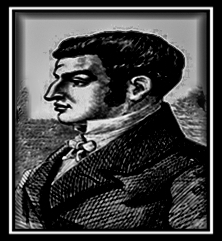
Following Donnelly’s death in 1820 public curiosity was reignited. In response, his old sparring partners had a spacious booth erected on the site at Donnybrook. The ‘Noble art of self-defence and sparring’ could be witnessed on admittance to the gallery.[34] The championship passed to Jack Langan. on Donnelly’s demise. He is perhaps best remembered for his bouts with Tom Spring (1824).[35]
It was at this time Langan toured England with (Tom) Reynolds[36] giving exhibitions at places like Liverpool and Manchester[37] Langan’s last engagement with Spring lasted some two and a half hours. It was said that Langan had fought under the black flag of ‘’ death or victory.’
Langan lost the fights but won the reputation. He returned to Dublin a hero.[38] However, his grand sparring match at Dublin’s Fishamble Theatre afforded him limited funds. Staged performances of this kind had lost their appeal.[39]
Hard blows and hard lives -1830S -1840s
Prize fighting continued, at times to the detriment of its participants. Dublin battler Robin Rough fought his last fight in February of 1826. He breathed his last breath the next February (he was 26 years old). The cause of death unclear, however, the champion of Scotland Alexander M’Kay lost his life as a direct result of a prize fight with the Irish champion Simon Byrne (1828).[40] This incident did not ruin Byrne, however. In fact, he engaged in a sparring exhibition (alongside Edwin Baldwin, Tom Spring and Tom Reynolds) at the Royal Hibernian Arena the following year. [41]
Byrne was back in the ring in 1833. He faced James ‘‘Deaf’’ Burke [42]for £100 a side. On this occasion he suffered injuries that resulted in his passing.[43]
After the deaths of several boxers in the 1830s, new prize fight rules were drawn up, but they did not yet sanction use of gloves in fights.
These timely deaths coincided with a general waning in the exhibition’s popularity. The latter being an established component of fistic culture (one facilitating the other) its downturn may have depleted the Pugilists’ finances. Perhaps contributing to them taking on contests when out of shape or even unwell. Yet, it is hard to paint a general picture. For instance, lifestyles must be taken into consideration.
Even so, the death of the Irish champion was one of a series of incidents that encouraged the enactment of London Prize Rules. However, it did not yet encourage the use of gloves. In actual fact, under Prize Ring Rules (introduced in 1838 and revised in 1853) they were banned. [44]
Nonetheless, there were some significant changes in exhibition boxing by this time. For instance, exhibitions often contained an amateur undercard.[45] Other exhibitions looked to be an architype of what was to come. For example, ‘’Young’’ Charles Langan[46] of Liverpool (by way of Dublin) was scheduled to fight ‘Deaf’ Burke in England in 1835.
Instead, Langan found himself in an altercation with the police. The fight was off, however, as an alternative, they endeavoured to show with the gloves what they would have done with bare fists. Langan who perhaps strictly adherent to a Prize Ring battles performed under par. Burke who could ‘’work it’’ with the glove’s hit his man all over the stage.[47]
The amateurs at work
A noteworthy case came before the courts in 1844. It featured a character named the’ notorious’ Cavan Egan. The alleged assault happened during what was described as a show exhibition at Mountrath (a small town in County Laois). Men were observed sparring in the pit and a witness, in the case, was asked to partake. There was no suggestion of this man being a pugilist. This shows us that the floor was open to member of the gallery.[48] It is interesting to see how gloved sparring had taken root in small towns and villages in Ireland. This was just a year before the great famine (1845–1849) and the practice, like all other forms of recreation, obviously suffered as a result.
Friend in the ring-foe in the ring
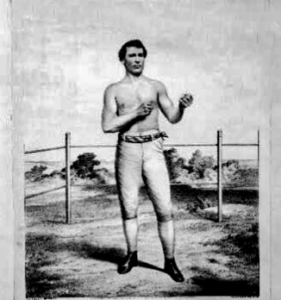
The Prize Ring was all but dead by 1860 a ‘melancholy relics of a departed fashion.’ [49] John C. Heenan the champion of America and the champion of England Tom Sayers met that year. It has often been described as the first international heavyweight title fight …’Erin-go-bragh, cried Heenan I want the English belt, when Tom let fly, saying, I will die, or keep the belt myself.’[50]
It consisted of 32 rounds of terrific milling. The ropes were cut by rowdies, but the bout nevertheless continued without a referee for several rounds until it was declared a draw.[51]Some publications condemned it, but there was also admiration. It did, in fact, give life to a sport in retreat.[52]
Again, the chaotic nature of the event does not seem to have caused much animosity. Instead of a return to the Prize Ring (to settle the score) Sayers and Heenan decided to capitalise on the notoriety (by way of exhibition sparring). Just as Ryan and Johnson had done before them, taking to the road while the iron was still hot.[53]
Exhibition matches could sometimes involve spectators being invited to spar with the professionals.
Their exhibition at the zoological Gardens in Liverpool had an admission of half a crown.[54]Not a bad undertaking once tickets sales were added up. They were received by large crowds at Dublin’s Rotunda Gardens later. This spectacle was enhanced by a clever acrobatic display, which lasted some fifteen minutes. They ascended the platform and exhibited the two prize belts to great applause.[55]
Next, they set about their exhibition. It was noted that -as the eye and hand of the pugilists engaged the interest of the spectators became very great. Some 8,000 people filled the gardens for the evening show. This was a substantial assemblage and for a generation brought up on the exploits of Donnelly and Byrne it was a chance to see Heenan. His Irish roots well established. In fact, he had remained with relatives while in the country. It is worth noting that Sayers may also have been of Irish parentage. [56]
Hats were blocked, and tails of coats torn off and other lawless acts committed.
While the champions put on their gloves trouble erupted outside of the ring. The platform was demolished, and a refreshment tent was torn down. Drink and cash received during the day carried off. It was said to be the worst riot the city had witnessed. Evidently, it had not gone well for the two champions and they left for Belfast. [57] The riot dampened the fire of the Prize Ring. It is rare that an exhibition outdone it as a scene of riot and rampage. Nevertheless, it was their gruelling prize fight that sparked debate on the Prize Rings future.
Pugilistic tournay’s continued and Dublin featured Joe Goss, Young Donnelly and Jem Mace in 1864[58] They were some of the best pugilists of the day. They were also first-rate with the gloves. This is clear from an account published in the Irish Examiner. …’’when they encountered each other (Mace and Goss) with the gloves the rapidity of their motion, the almost instantaneous quickness with which they dealt and parried strokes, and the finished style of their sparring, were such as to strongly impress every one capable in the least of sympathizing in their practices. ‘’[59]
Prize fighters had certainly gained a high level of competence with the gloves. But, there was no thrill like a fistic display (naked fists). The much-anticipated fight between Irish born American Champion Joe Coburn and the English champion Jem Mace was scheduled to take place in Ireland in 1864. However, it was dogged by arguments over the referee and under the scrutiny of the Royal Irish Constabulary. It never went ahead. But, there was a boxing extravaganza at the Prince of Wales Theatre’’[60] two nights previous to it.
Under the assisted by the London Liverpool and Dublin fancy, it featured James Cusick (Heenan’s trainer), Jack Hicks, Job Colley, and Ted Napper.[61]This was perhaps the last exhibition in Ireland before the introduction of Queensbury rules in 1865. They would in theory substitute boxing gloves for the naked fist and the Marquis of Queensbury Rules for the London Prize Rules. Putting the exhibition on a different footing. No longer the only acceptable form of gloves engagement. However, it was not as if they waved a magic wand and the glove (at once) were supplanted by the fist. Indeed, it would take considerable time before they were embraced wholly.
In summary
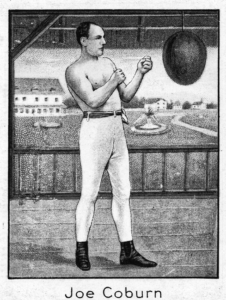
The contestants in the old Prize Ring are often portrayed as machines. The battles they undertook were momentous. Yet they too were human, with all the frailties of our species, they bled, loved and expired.
They conducted their business in a time that lacked any system of public welfare. In fact, Ireland had no general policy on the part of government to contain the problem of poverty, until the introduction in the 1830s of the controversial ‘workhouse’ poor law system.[62] Instead, the pugilist navigated the unpredictable Prize Ring the best way they could. They made their guineas with the fist. However, they received their shillings and crowns by conducting gloved exhibitions and giving instruction on the noble art (often in conjunction with each other).
The Prize Ring was revived and somewhat reformed in the 1860s. However, pugilism carried on in much the same manner as it had a hundred years prior. The exhibition continued to exist as a step into the sport. It showcased the gloves and attracted aspiring pugilists. It was, in all deductions, the earliest form of gloved boxing on display to a paying audience; an imperative part of the sports development that is often overlooked.
See also, Scrapping – The Early Years, Dublin Boxing in the 18th and early 19th century by Ray Esten.
References
[1] Maurice Golesworthy The Encyclopaedia of boxing (London 1960) p. 93
[2] The Modern Art of Boxing, as practiced by Mendoza, Humphries, Ryan, Ward, Watson, Johnson and other eminent Pugilists. To which are added, The Six Lessons of Mendoza as published by him, for the use of his scholars, and full account of his battle with Humphries (1789) p. 31.
[3] Police Budget Edition ‘Famous Fights’ past and present Vol. VIII. No. 93.
[4] The gloves were used in a competitive fight at Aix-la-Chapelle in France in 1818. However, this was an isolated instance and was not repeated with any force.
[5] Richard Killeen Historical Atlas of Dublin (Dublin 2009) p. 82.
[6] David Dickson New Foundations Ireland 1660-1800 (Dublin 2008) PP. 185-6.
[7] Kevin Boyle Police in Ireland before the union: II Irish jurist new series, Vol. 8, No. 1 (Summer 1973) p. 91.
[8] Tom Sawyer Noble, Art an artistic and literary celebration of the Old English prize-ring. (Great Britain 1989) p. 22.
[9] James Kelly Sport in Ireland 1600-1840 (Dublin 2014) p. 290.
[10] There are numerous Irish names amongst the prize fights of England. They include the championship of Peter Corcoran and Duggan Fearns.
[11] Ryan fought Johnson on two separate occasions and could possibly have won both. Had it not been for his temper. His son Bill followed him into the Prize Ring. He had two battles with the renowned Jem Belcher (the brother of Tom Belcher). He won the first fight and lost the rematch.
[12] W. Buchanan-Taylor and James Butler What do you know about Boxing? (London 1947) p. 185.
[13] Second- the person who backs another in fighting, and sees that he is not dealt unfairly.
[14] Police Budget Edition ‘Famous Fights’ past and present Vol. V No.61.
[15] Lewis Edward Daniel Mendoza Transactions (Jewish Society of England), 1939-1945, Vol. 15 (1939-1945), PP. 81-7.
[16] W. Buchanan-Taylor and James Butler What do you know about Boxing? (London 1947) p. 180.
[17] Lewis Edward Daniel Mendoza Transactions (Jewish Society of England), 1939-1945, Vol. 15 (1939-1945), PP. 81-7.
[18] Henry Downes Miles Pugilistica: The History of British Boxing containing lives of the most celebrated pugilists; full reports of their battles from contemporary newspapers, with authentic portraits, personal anecdotes, and sketches of the principle patrons of the prize ring, forming a complete history of the ring from Fig and Broughton, 1719-40, to the last championship battle between King and Heenan, in December 1863 Vol. 2 (Edinburgh 1906) p. 64.
[19] Pancratia History of Pugilism containing a full account of every battle of note from the time of Broughton and Slack (London 1812) p. 124.
[20] Police Budget Edition ‘Famous Fights’ past and present Vol. VIII. No. 93.
[21] The Curragh was Ireland premier sporting location. The name means ‘marshy waste ground’ a befitting name for a place in which Irishmen raised their fists.
[22] The Sporting Magazine Vol. XLII.-No. 284.
[23] Tom Belcher and Tom Hall operated the boxing school. On their meeting at the Curragh (they had met before) Belcher again proved the better man. Though, from the records it was not as one sided as it has been portrayed.
[24] James Kelly Sport in Ireland 1600-1840 (Dublin 2014) p. 302.
[25] Boxiana or, Sketches of Modern Pugilism, from the championship of Cribb to the present time by P. Egan Vol. II (England 1824) p. 394.
[26] Patrick Halton was a formidable fighter who had fought a (controversial) draw with Jack Langan. Had wins over the two Johnsons, Slack and lost a close battle with Aby Belasco
[27] Boxers and their battles anecdotal sketches and personal recollections of famous pugilists by Thormanby (London 1900) p. 66.
[28] Boxiana or, Sketches of Modern Pugilism, from the championship of Cribb to the present time by P. Egan Vol. IV (England 1824) p. 544.
[29] W. Buchanan-Taylor and James Butler What do you know about Boxing? (London 1947) pp. 90-1
[30] The Fancy; or True Sportsman’s Guide being Authentic Memories of the lives, actions, prowess, and battles of the leading pugilists, from the days of Figg and Broughton, To the Champion of Ward by An Operator. Vol. 1. (London, 1826) p. 372.
[31] James Kelly Sport in Ireland 1600-1840 (Dublin 2014) p. 304.
[32] Gregson was a renowned English pugilist and aspiring poet who had fought Tom Cribb, John Gully. He ran a pub on Dublin’s Moore Street.
[33] Ed James. N.Y. Life and battles of Sir Dan Donnelly (New York 1879) p. 22.
[34] Freemans Journal Monday, August 28, 1820.
[35] Places like Liverpool and Manchester had significant Irish communities and could be more lucrative to men like Langan.
[36] Tom Reynolds was born in Armagh and raised in England. He fought a number of battles including a sixty-six-round win over Abby Balasco. He had quasi-literary ability and was credited with ushering Jack Langan and Simon Byrne into public life. He fell through a cellar-flap. This forced him to take up sparring as a profession. He died in Dublin aged 41.
[37] Adam Chill Bare-Knuckle Britons and Fighting Irish: Boxing, Race, Religion and Nationality in the 18th and 19th century (United States 2017) p. 141.
[38] Henry Downes Miles Pugilistica: The History of British Boxing containing lives of the most celebrated pugilists; full reports of their battles from contemporary newspapers, with authentic portraits, personal anecdotes, and sketches of the principle patrons of the prize ring, forming a complete history of the ring from Fig and Broughton, 1719-40, to the last championship battle between King and Heenan, in December 1863 Vol. 2 (Edinburgh 1906).
[39] James Kelly Sport in Ireland 1600-1840 (Dublin 2014) p. 307.
[40] Police Budget Edition ‘Famous Fights’ Past and Present Vol. V. No. 61.
[41] Freemans Journal September 07, 1829.
[42] James ‘’Deaf’’ Burke was born in London to Irish parents. He was one of the most active Pugilists of the era. He contested in all some 20 contests.
[43] Tom Sayers, Sometime Champion of England, His Life and Pugilist Career (1866) p. 10.
[44] Police Budget Edition ‘Famous Fights’ past and present Vol. VIII. No. 93.
[45] During the sparring extraordinary in 1829 (Royal Hibernian arena) Byrne, Spring and Reynolds were assisted by the first-rate amateurs.
[46] Charles Langan does not seem to be any relation to Jack Langan.
[47] Police Budget Edition ‘Famous Fights’ past and present Vol. VIII. No. 92.
[48] Leinster Express July 08, 1843.
[49] Tom Sayers, Sometime Champion of England, His Life and Pugilist Career (1866). p xxi.
[50] Tom Sawyer Noble, Art an artistic and literary celebration of the Old English prize-ring. (Great Britain 1989) p. 74.
[51]The Ring Vol. XXVII June 1948 No. 5.
[52] It is worth noting that Tom Sayers later refused a rematch with Heenan and instead he announced his retirement.
[53] Heenan and Sayers had fought just two months prior in what was by all accounts a gruelling contest. It is both testament to their mettle and to the allure of the exhibition that they continued with the sparring tour.
[54] Irish Examiner June 08, 1860.
[55] The contest declared a draw the two men had been issued with championship belts.
[56] Tom Sayers, Sometime Champion of England, His Life and Pugilist Career (1866). P. 15.
[57] Dundalk Democrat June 30, 1860.
[58] Freemans Journal February 27, 1864.
[59] Irish Examiner April 25, 1864.
[60] The venue is perhaps best remembered as the Fishamble Music Hall. Handel performed ‘’messiah’’ there on the 19th December 1775.
[61] Freemans Journal September 28, 1864.
[62] Deidre Lindsay Dublin’s Oldest Charity. The Sick and Indigent Roomkeepers Society 1790-1990 (Dublin 1990) p. 1.